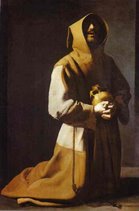Joseph Ratzinger’s Daughter Zion: Meditations on the Church’s Marian Belief is taken from a series of lectures and was first published in English in 1983. In some ways, it is an elaboration of particular points presented in Hugo Rahner’s Our Lady and the Church (originally published in 1961), a work that rediscovers the beliefs of the Church Fathers through their writings: Mary is a type of the Church; what is true of Mary and fulfilled in her is also true and fulfilled in the Church. (See also John Paul II’s encyclical Redemptoris Mater, 1987). Ratzinger takes up this point and proposes that the theological neglect of Mary in this century is attributable to poor typological exegesis (established in Romans 5) of the Old and New Testaments.
After making the first parallel to Mary as the New Eve (as did Irenaeus), Ratzinger makes a parallel I have never read before: between Mary and the pairs of Sarah-Hagar, Rachel-Leah, and Hannah-Peninna. In the way that the Old Testament and covenant are a shadow of the New, Ratzinger points out that those pairs of women in the Old Testament, contrasted as infertile and fertile, can only be understood through the reality of Mary and her virginity:
“infertile ultimately turns out to be the truly blessed….Barrenness as the condition for fruitfulness – the mystery of the Old Testament mothers becomes transparent in Mary….In this “new birth” [the birth of the Messiah], which simultaneously included the abandonment of earthly fertility, of self-disposal, and of the autonomous planning of one’s life…to bear the Son includes the surrender of oneself into barrenness.” Hannah’s prayer in 1 Samuel 2 foreshadows Mary’s own Magnificat (Luke 1:46-55). Suddenly, the teaching of the
Ratzinger also points out another reality related to Christ - that of the younger son usurping the older one and seizing the inheritance: Isaac-Ishmael and Jacob-Esau are shadows of Christ-Adam.
Ratzinger elaborates on the type of the woman-savior (Esther and Judith) and on Mary as daughter
The final issue Ratzinger tackles is the Assumption of Mary, standing for the definitive state of salvation of the Church. Death and decay occur because of sin, out of self-determination. To be in Christ is only life (Ephesians 2:6).
Almost all the truths of the Church involve paradoxes: Christ is God and man, Mary is virgin and mother, God is Three in One, death brings forth eternal life. Here, Ratzinger adds that virginity is fruitfulness, dispossession is belonging, and renunciation is fulfillment. In Truth and Tolerance Ratzinger writes that what separates Christianity from Eastern religions is that in the former, God is present and available, not through special knowledge or pursuit but through nothing grander than one’s consent to Him.
God confronts us as Other, but Marian teaching reaffirms that (paraphrased) God really does act in the world, and because of it, the earth produces fruit. And he acts on persons, not on ideas or concepts. The Church, the new
Ratzinger ends his meditation on Mary by reminding us of Mary as the Ark of the Covenant (the parallel between 2 Samuel 6:11-16 and Luke 1:39-56).
But I’d like to reproduce here something else from the text, dealing with the virgin-birth:
The world-view which would force us psychologically to declare the virginal birth an impossibility clearly does not result from knowledge, but from an evaluation. Today, just as much as yesterday, a virgin birth is improbable, but in no way purely impossible. There is no proof for its impossibility, and no serious natural scientist would ever assert that there was. What ‘compels’ us here to declare the maximum inner-worldly improbability an impossibility, not only for the world but also for God, is not knowledge but a structure of evaluations with two principal components: one consists in our tacit cartesianism – in that philosophy of emancipation hostile to creation which would repress both body and birth from the human reality by declaring them merely biological; the other consists in a concept of God and the world that considers it inappropriate that God should be involved with bios and matter. In reality, precisely when we talk abut corporeality and raise suspicions about the soul, we are dualists.
The subject of presuppositions, especially involving faith and reason, is elaborated on at length in other works by Ratzinger, and is reflected in his famous

1 comment:
There's a new book out: Mary for Evangelicals: Toward an Understanding of the Mother of Our Lord by Tim Perry (2006), that focuses on Mariology within Protestant paradigms. It's discussed here: http://faith-theology.blogspot.com/2006/11/tim-perry-mary-for-evangelicals.html
Post a Comment